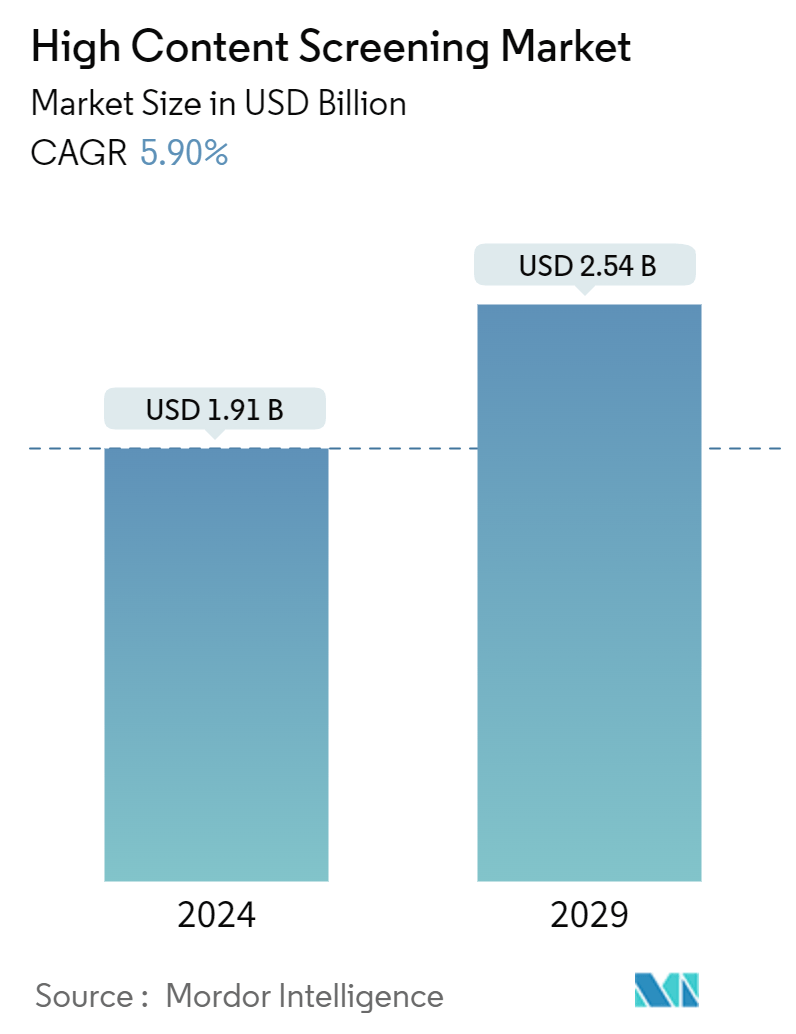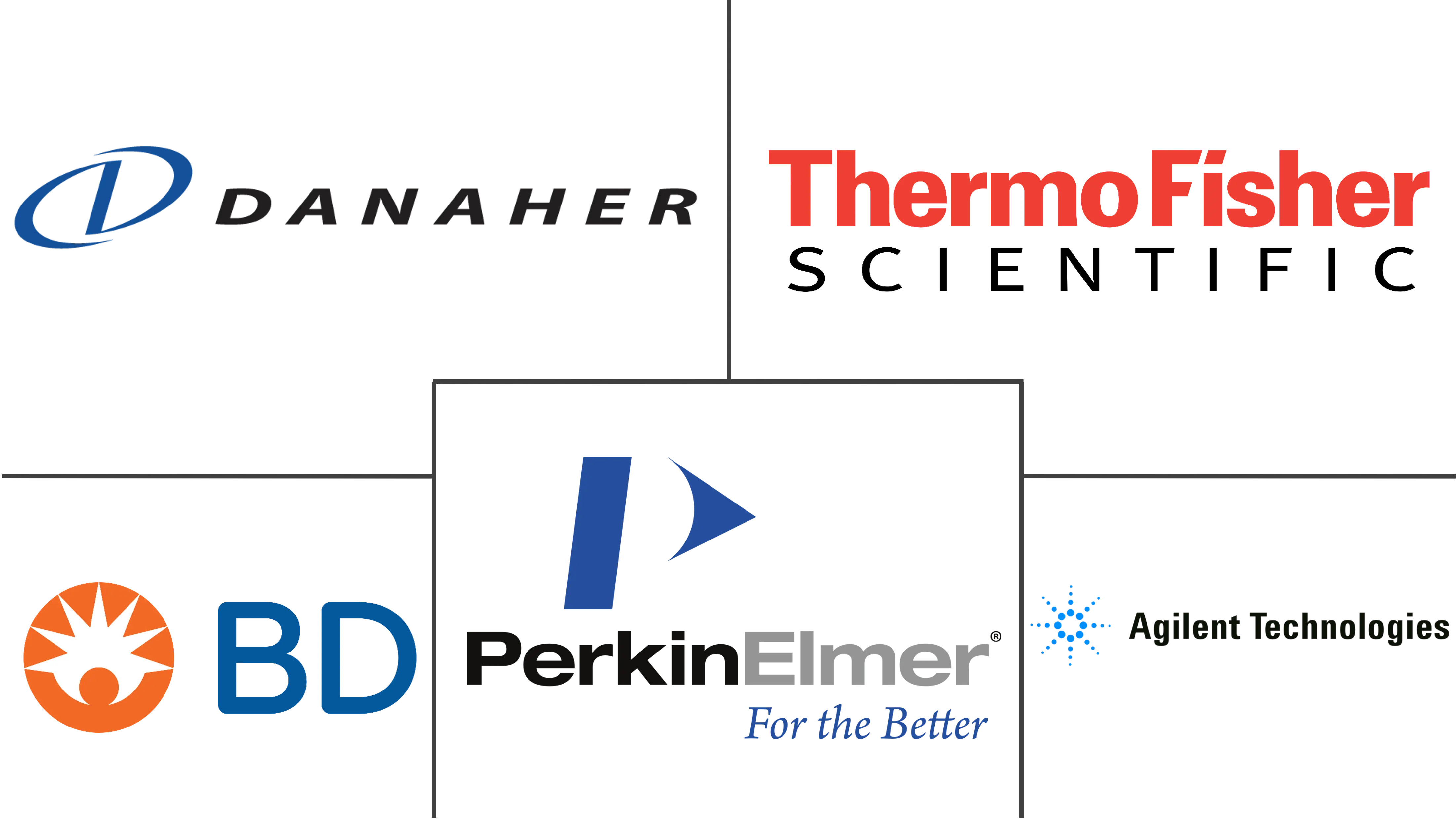Market Size of High Content Screening Industry

| Study Period | 2019 - 2029 |
| Market Size (2024) | USD 1.91 Billion |
| Market Size (2029) | USD 2.54 Billion |
| CAGR (2024 - 2029) | 5.90 % |
| Fastest Growing Market | Asia-Pacific |
| Largest Market | North America |
Major Players
*Disclaimer: Major Players sorted in no particular order |
High Content Screening (HCS) Market Analysis
The High Content Screening Market size is estimated at USD 1.91 billion in 2024, and is expected to reach USD 2.54 billion by 2029, growing at a CAGR of 5.90% during the forecast period (2024-2029).
The outbreak of COVID-19 has turned the spotlight on the high-content screening market as most biopharmaceutical players were engaged in the development of novel therapeutics against the SARS-CoV-2 virus. Due to the increase in drug discovery, there was an increasing demand for drug testing products and services to monitor and evaluate the toxicity of a specific vaccine before commercializing it to the market. Due to this, the pandemic had a positive impact on the high-content screening market. According to the research article published in the American Chemical Society Pharmacology and Translational Science in 2020, new potential therapeutics for COVID-19 identified with a combined virtual and experimental screening strategy and selected from among the already approved drugs were studied to screen for structural similarity against a library of almost 4000 approved drugs with hydroxychloroquine (HCQ) as a reference drug. The study proposed zuclopenthixol, nebivolol, and amodiaquine as potential candidates for clinical trials against the early phase of the SARS-CoV-2 infection and remdesivir and favipiravir therapeutics as potential adjuvants in COVID-19 treatment. With the rising use of high-content screening for such studies, COVID-19 significantly impacted the market studied. The market is expected to show stable growth during the forecast period.
The need for cost containment in pharmaceutical research and development, advancements in informatics solutions and imaging instruments, and government funding and venture capital investments across developed markets are the major factors driving the growth of the High-Content Screening (HCS) Market.
Under the conventional method of toxicity studies, large libraries are screened in search of potential drug candidates. The traditional way is expensive, resource- and time-consuming, and it has a low success rate. Consequent High-Content Screening (HCS) solutions for testing the potential toxicity of chemicals and complex substances are being adopted by pharmaceutical companies to improve in-vitro toxicity testing by reducing the time and cost. The increasing number of contract research organizations providing HCS outsourcing services and the application of HCS in personalized medicine present significant growth opportunities in the market.
The recent technological developments by the market players and researchers, rising investments, and rising research and development activities worldwide are contributing to the growth of the studied market. For instance, in October 2021, BD Life Sciences-Biosciences launched its second Center of Excellence (CoE) in flow cytometry for clinical research in India in collaboration with Christian Medical College, Vellore. The partnership will allow hematologists, doctors, and lab professionals from all over India to deliberate and discuss standardization and best practices in clinical flow cytometry. This CoE will function as the National Reference Center for clinical diagnostics applications and is estimated to propel the High-Content Screening Market during the forecast period.
Furthermore, in April 2022, CytoTronics received USD 9.25 million in initial seed funding led by Anzu Partners, with participation from Milad Alucozai (BoxOne Ventures) and institutional investors. This funding will allow the company to commercialize its research-demonstrated devices for cell-based drug screening in multiple areas, such as oncology, gastroenterology, cardiology, and neurology. It is likely to expand its offerings in terms of bringing technologically advanced products to the market for drug screening purposes which is expected to propel the High-Content Screening Market during the forecast period.
Hence, with the factors such as rising healthcare investment, and increasing strategic initiatives by key players, it is believed that the market studied will witness healthy growth over the forecast period.
High Content Screening (HCS) Industry Segmentation
As per the scope of the report, High Content Screening (HCS) is a method that is used in biological research and drug discovery to identify substances, such as small molecules, peptides, or RNAi, that alter the phenotype of a cell in the desired manner. High-content screening includes any method used to analyze whole cells or components of cells with a simultaneous readout of several parameters.
The High Content Screening Market is Segmented by Type of Product (Instruments, Consumables, Software, and Services), Application (Primary and Secondary Screening, Target Identification and Validation, Toxicity Studies, Compound Profiling, and Other Applications), End User (Pharmaceutical and Biotechnology Companies, Academic and Government Institutions, Contract Research Organization), and Geography (North America, Europe, Asia-Pacific, Middle East and Africa, South America). The market report also covers the estimated market sizes and trends for 17 different countries across major regions, globally. The report offers the value (USD million) for the above segments.
| By Product | |||||
| |||||
| |||||
| Software | |||||
| Services |
| By Application | |
| Primary and Secondary Screening | |
| Target Identification and Validation | |
| Toxicity Studies | |
| Compound Profiling | |
| Other Applications |
| By End User | |
| Pharmaceutical and Biotechnology Companies | |
| Academic and Government Institutions | |
| Contract Research Organization |
| Geography | ||||||||
| ||||||||
| ||||||||
| ||||||||
| ||||||||
|
High Content Screening Market Size Summary
The High-Content Screening (HCS) market is experiencing significant growth, driven by the increasing demand for drug discovery and the need for efficient toxicity testing solutions. The COVID-19 pandemic has further accelerated this growth, as biopharmaceutical companies sought to develop novel therapeutics, highlighting the importance of HCS in evaluating vaccine safety and efficacy. The market is benefiting from advancements in informatics solutions and imaging instruments, as well as increased government funding and venture capital investments. These factors are enabling pharmaceutical companies to adopt HCS solutions, which offer cost-effective and time-efficient alternatives to traditional toxicity studies. The rise of contract research organizations providing HCS outsourcing services and the application of HCS in personalized medicine are also contributing to the market's expansion.
Technological advancements and strategic initiatives by key players are propelling the HCS market forward. Notable developments include the establishment of Centers of Excellence for clinical research and significant funding for companies like CytoTronics to commercialize advanced cell-based drug screening devices. Flow cytometry, a key component of HCS, is gaining traction due to its high-speed quantitative analysis capabilities, making it an attractive tool for drug discovery and cancer detection. North America is expected to hold a substantial market share, driven by extensive research and development activities, the high prevalence of chronic diseases, and technological advancements in HCS methods. The competitive landscape of the HCS market includes major players such as Agilent Technologies, Cytiva, and Thermo Fisher Scientific, who are actively engaging in product launches and technological innovations to enhance their offerings.
High Content Screening Market Size - Table of Contents
-
1. MARKET DYNAMICS
-
1.1 Market Overview
-
1.2 Market Drivers
-
1.2.1 Government Funding and Venture Capital Investments Across Developed Markets
-
1.2.2 Increasing Applications of High Content Screening in Life Science Research
-
1.2.3 Advancements in Informatic Solutions and Imaging Systems
-
-
1.3 Market Restraints
-
1.3.1 Lower Adoption of High Content Screening Instruments Due to Their High Prices
-
-
1.4 Porter's Five Forces Analysis
-
1.4.1 Threat of New Entrants
-
1.4.2 Bargaining Power of Buyers/Consumers
-
1.4.3 Bargaining Power of Suppliers
-
1.4.4 Threat of Substitute Products
-
1.4.5 Intensity of Competitive Rivalry
-
-
-
2. MARKET SEGMENTATION (Market Size by Value - USD million)
-
2.1 By Product
-
2.1.1 Instruments
-
2.1.1.1 Cell Imaging and Analysis Systems
-
2.1.1.2 Flow Cytometers
-
-
2.1.2 Consumables
-
2.1.2.1 Reagents and Assay Kits
-
2.1.2.2 Microplates
-
2.1.2.3 Other Consumables
-
-
2.1.3 Software
-
2.1.4 Services
-
-
2.2 By Application
-
2.2.1 Primary and Secondary Screening
-
2.2.2 Target Identification and Validation
-
2.2.3 Toxicity Studies
-
2.2.4 Compound Profiling
-
2.2.5 Other Applications
-
-
2.3 By End User
-
2.3.1 Pharmaceutical and Biotechnology Companies
-
2.3.2 Academic and Government Institutions
-
2.3.3 Contract Research Organization
-
-
2.4 Geography
-
2.4.1 North America
-
2.4.1.1 United States
-
2.4.1.2 Canada
-
2.4.1.3 Mexico
-
-
2.4.2 Europe
-
2.4.2.1 Germany
-
2.4.2.2 United Kingdom
-
2.4.2.3 France
-
2.4.2.4 Italy
-
2.4.2.5 Spain
-
2.4.2.6 Rest of Europe
-
-
2.4.3 Asia-Pacific
-
2.4.3.1 China
-
2.4.3.2 Japan
-
2.4.3.3 India
-
2.4.3.4 Australia
-
2.4.3.5 South Korea
-
2.4.3.6 Rest of Asia-Pacific
-
-
2.4.4 Middle East and Africa
-
2.4.4.1 GCC
-
2.4.4.2 South Africa
-
2.4.4.3 Rest of Middle East and Africa
-
-
2.4.5 South America
-
2.4.5.1 Brazil
-
2.4.5.2 Argentina
-
2.4.5.3 Rest of South America
-
-
-
High Content Screening Market Size FAQs
How big is the High Content Screening Market?
The High Content Screening Market size is expected to reach USD 1.91 billion in 2024 and grow at a CAGR of 5.90% to reach USD 2.54 billion by 2029.
What is the current High Content Screening Market size?
In 2024, the High Content Screening Market size is expected to reach USD 1.91 billion.

